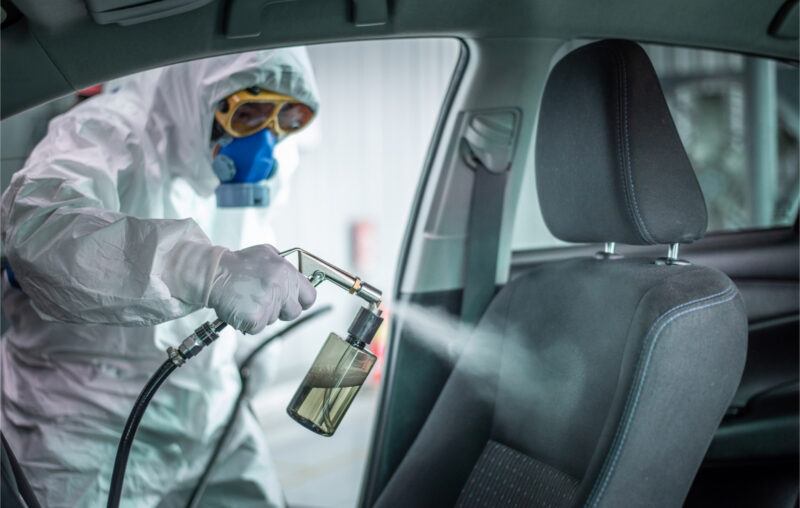How Much Does Cleaning Everything Really Help?

We’ve spent the better part of a year drowning in cleaning products, somehow certain we are scrubbing the virus off surfaces so that we don’t get sick. It seems to fit with a certain intuition that the bad germ is not within you or me but must be sticking to some surface. It’s a mental habit from time immemorial to externalize the pathogen. With the wide availability of cleaning products, we all went crazy to get the invisible enemy.
Even now, governments require businesses (or businesses may choose) to clean more than necessary, which results in businesses’ giving up other tasks. While excessive cleaning may appear effective, an article from The Washington Post argues “We are over-cleaning in response to covid-19.”
In the article, Harvard professor John G. Allen and Drexel professor Charles Haas clarify that there is not sufficient scientific evidence to say that Covid-19 is mainly transmitted through contaminated surfaces. The authors suggest that deeply cleaning surfaces – whether they be door knobs, light switches, or countertops – have little to no effect on curbing the virus’s spread.
Another article from The Wall Street Journal echoes the same idea. They quote Deborah Roy, president of the American Society of Safety Professionals:
Sanitation is important in general always…The idea is we went overboard at the beginning because of the amount of unknowns. Now, we’re in a situation where we have more information.
The Washington Post writers reveal the overarching problem with this misunderstanding, stating: “The intense focus on fomite [inanimate surface] transmission is a critical issue because organizations are spending massive amounts of time – and money – addressing a ghost problem.” In other words, the focus on hyper-cleaning comes at a great cost for businesses forced to reallocate resources toward unnecessary activities.
Walmart spent $300 million on cleaning over thirteen weeks during the pandemic. While a Walmart is a big business, millions of dollars are ultimately spent towards “a ghost problem” and can be better directed towards more productive ends, such as increasing worker wages, refining supply chains (which were disrupted by the pandemic), or offering lower prices to customers.
An article from Nature underscores the problem of over-cleaning and the associated high costs to governments, businesses, and individuals:
By the end of 2020, global sales of surface disinfectant totalled US$4.5 billion, a jump of more than 30% over the previous year. The New York Metropolitan Transit Authority (MTA), which oversees subways and buses and lost billions of dollars in passenger revenue in 2020, spent $484 million last year in its response to COVID-19, including enhanced cleaning and sanitization.
On a smaller scale, your mom-and-pop shops may not have the wherewithal to do what Walmart can. With limited funds, employees, and resources, following cleaning guidelines becomes ever more cumbersome.
The reality of this situation is more illuminating when you inspect the numbers. Let’s pretend that a mom-and-pop store goes through two containers of wipes once a week and a gallon of bleach every two weeks. At your typical home improvement store, a container of 80 Lysol wipes costs $5 and a gallon of bleach about $6. When calculated, the products reach a total of $676 for the whole year.
What about time and labor spent cleaning? According to Massachusetts safety standards, “businesses should reduce operating hours to allow for on-going off-hour sanitation and cleaning.” If businesses had one employee cleaning for two hours daily at Massachusetts minimum wage, the cost is about $9,828 for an entire year. Adding products and labor together, the total is around $10,504, which still ignores other needed materials (masks, gloves, paper towels).
The $10,504 also does not begin to account for business lost from having to cut operating hours. Small businesses with tight profit margins could see these costs consume a large portion of already narrow overall profits. While these calculations are hypothetical, they demonstrate the expensive reality that small (and large) businesses now face.
Meanwhile, many studies indicate that surface transmission is rare and overemphasized. In The Lancet article “Exaggerated risk of transmission of COVID-19 by fomites,” Rutgers Professor Goldman states,
In my opinion, the chance of transmission through inanimate surfaces is very small, and only in instances where an infected person coughs or sneezes on the surface, and someone else touches that surface soon after the cough or sneeze (within 1–2 h).
In Military Medicine, authors similarly assert, “…we suggest fomite spread may not be a significant means of transmission for severe acute respiratory syndrome coronavirus 2 in real-world operational scenarios.”
These are just two articles of many that explain rare fomite spread.
This all is not to say that businesses should not clean out of their own volition. Cleaning is useful for maintaining a presentable establishment and washing away other viruses that are more easily transmitted through surfaces. In addition, it may be a necessary means for businesses to ensure their customers and employees feel comfortable.
So, given the high costs and lack of scientific evidence, why do people continue to misunderstand the science and over-clean?
The greater problem arises when action-biased politicians create mandates that restrict business behavior and force them to clean despite lacking scientific support. Action bias describes the idea that one would prefer to do something – such as excessively clean – rather than nothing at all, even if the action is ineffective or costly. The Washington Post authors similarly refer to this idea as “hygiene theater,” meaning cleaning is merely performative.
Despite lacking scientific evidence, politicians still institute cleaning rules to appear proactive. A governor or mayor who mandates deep cleaning may feel a sense of satisfaction for requiring businesses to be safe and also enjoy appearing socially conscious and assertive.
Across the United States, governors instituted rules for businesses to follow in order to make them secure for customers. In New York, for example, the governor released a five-page document, listing all Covid-19 guidelines. On the cleaning front, businesses must:
Regularly clean and disinfect the establishment and more frequently clean and disinfect high risk areas used by many individuals and for frequently touched surfaces (e.g. restrooms). Cleaning and disinfection must be rigorous and ongoing and should occur at least after each shift, daily, or more frequently if needed.
In addition to cleaning, restaurant owners must follow other lengthy and detailed guidelines relating to physical distancing, protection equipment, communication, and screening. These requirements compounded by the fact that they must close early for ample cleaning time only adds salt to the wound as they lose essential business hours.
On The Centers for Disease Control’s website, there is a lengthy and detailed page dedicated to “Guidance for Cleaning and Disinfecting Public Spaces, Workplaces, Businesses, Schools, and Homes.” Amid the details of which cleaning products to use and how many tablespoons of bleach are needed in a cleaning solution, there is a complete omission of the fact that Covid-19 fomite transmission is rare.
While businesses may choose to clean to make customers feel more comfortable when visiting their establishments, there is still an issue with the general public misunderstanding how Covid-19 spreads. Not only have governors instituted costly mandates, but their messaging on Covid-19 is misleading.
A Savanta poll surveying 2,331 adults in England demonstrates how citizens confound the best practices to protect themselves from the virus. Twenty seven percent of respondents surveyed said that the main Covid guidance from the UK government was hand washing and sanitizing surfaces, while only five percent said it was “about avoiding unventilated indoor places.” This statistic is disconcerting because scientists continuously find that Covid-19 is mainly transmitted by air (not surfaces), which would indicate that avoiding unventilated places would be a more effective prevention strategy.
Misleading messaging and political bias favoring a “do something” approach may be to blame for why businesses are incurring enormous losses. While the aim is to prevent the spread of the virus, they may be creating more harm than good. The correct information and resulting rearrangement of business priorities will lead businesses to make more lucrative and better informed decisions.
At the end of the day, these issues all boil down to opportunity cost. The time and resources directed towards extra cleaning could be used for an alternative activity that would reap higher benefits for the business, especially in the midst of economic turmoil.










